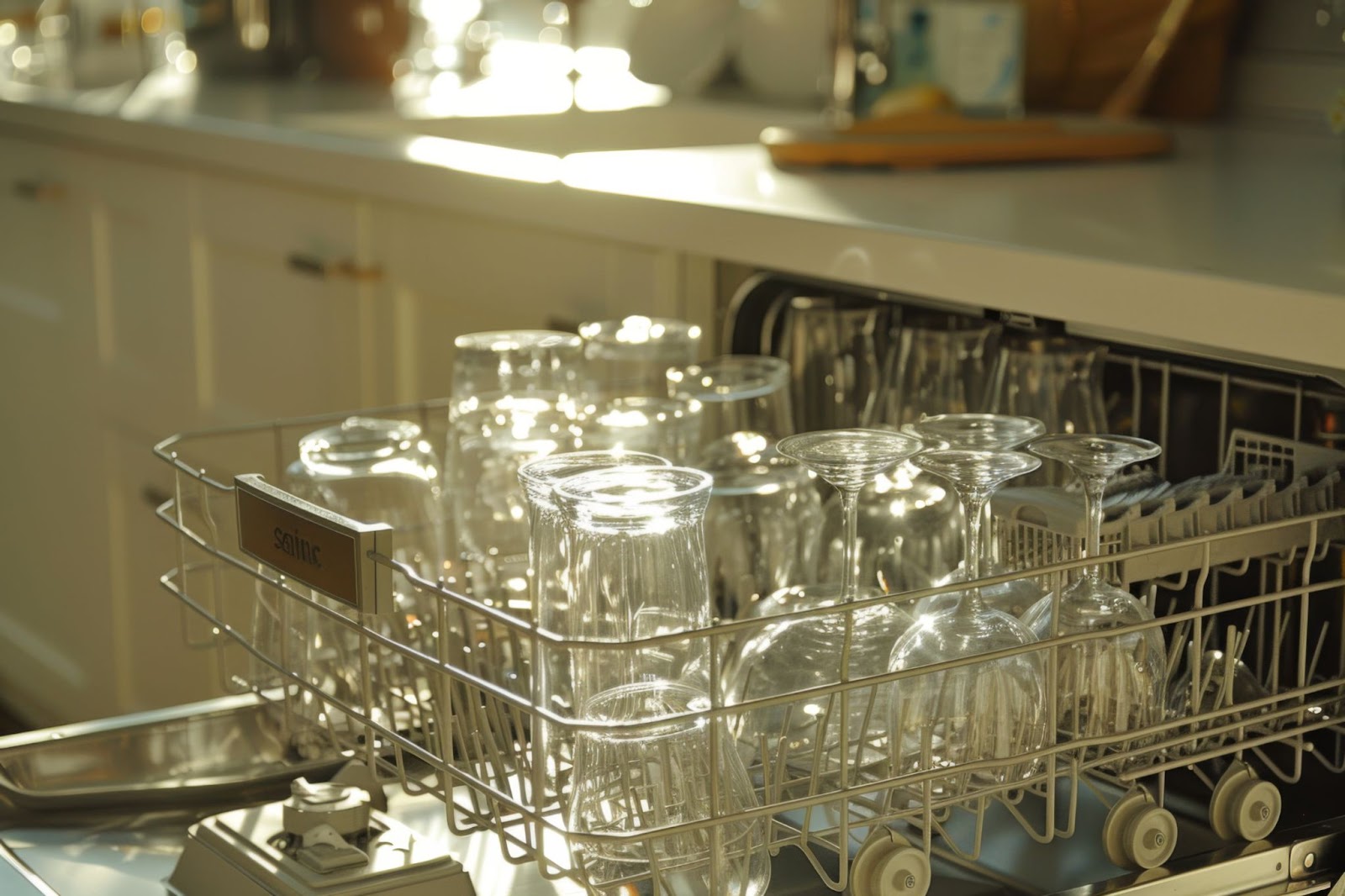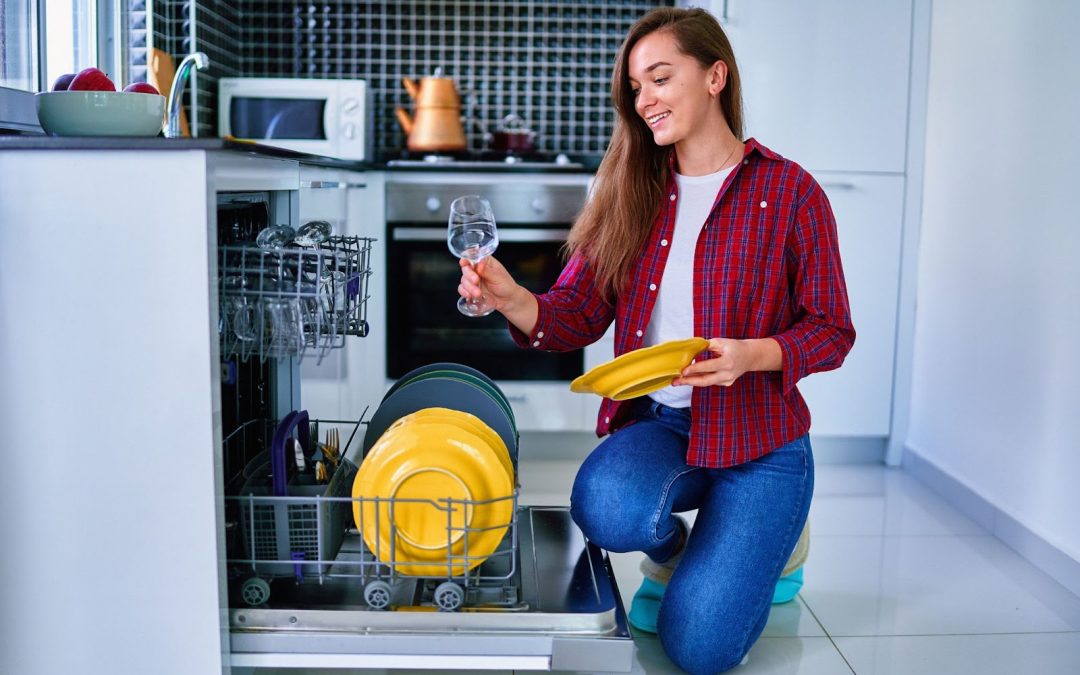If your sparkling glassware looks dull and cloudy after a cycle in the dishwasher, you’re not alone. No one enjoys pulling out what should be sparkling glasses only to find them covered in a milky haze. Mineral deposits, hard water stains, and leftover detergent buildup are common culprits that turn your beautiful glassware into lifeless dishes.
Even the most advanced dishwashers struggle to keep glassware perfectly clear, leaving you frustrated and searching for a solution.
Luckily, there’s no need for fancy, expensive products to solve this problem. The answer is simple, affordable, and probably sitting in your pantry right now — vinegar.
Known for its versatility in cleaning, vinegar’s natural acidity cuts right through the buildup, dissolving mineral deposits and washing away detergent residue. It works without the use of harsh chemicals, making it a safer and more eco-friendly option compared to many commercial products.
Adding a small amount of vinegar to your dishwasher makes a huge difference. Whether you’re prepping your glassware for a special occasion or simply want your everyday dishes to gleam like new, this quick and easy hack guarantees impressive results. No extra scrubbing or effort is needed — sparkling, crystal-clear glassware with minimal fuss.
Why glassware gets cloudy
Cloudy glassware is one of those common, yet deeply frustrating household problems. You run your dishes through the dishwasher expecting pristine, clear results, only to be met with dull, foggy glasses. This issue often boils down to a combination of factors, the biggest culprits being mineral deposits, hard water, and detergent residue.
Hard water is a major factor in cloudy glassware. Water rich in minerals, especially calcium and magnesium, doesn’t simply wash your dishes — it leaves behind invisible traces that, over time, build up into that stubborn, cloudy film you see on your glasses. When these minerals mix with heat and detergent during the washing process, they crystallize on your glassware, creating a dull, frosted effect.
This is particularly troublesome for those living in areas with high mineral content in their water, where the problem seems almost unavoidable. Even with the latest and most advanced dishwashers, hard water often defeats your efforts for perfectly clear dishes.
But hard water isn’t the only factor at play. Detergent residue also contributes to the cloudy appearance of your glassware. If too much detergent is used, or if your dishwasher’s rinse cycle isn’t thorough enough, leftover detergent dries on your glasses, creating a film that refuses to wash away.
Even the type of detergent you use will make a difference. Over time, the combination of hard water minerals and detergent residue accumulates, leaving your glasses looking perpetually foggy, no matter how many times you run them through the dishwasher.
The power of vinegar in the dishwasher

Fortunately, vinegar is the secret weapon to break this frustrating cycle. A powerhouse cleaner that’s been trusted for generations, vinegar’s natural acidity effectively dissolves the mineral deposits left behind by hard water.
It works by cutting through the grimy film dulling your glassware, restoring the clear, sparkling shine you’ve been missing. A cup of vinegar added to your dishwasher during a wash cycle breaks down even the most stubborn mineral buildup, leaving your glassware spotless.
Not only does vinegar combat hard water deposits, but it also tackles detergent residue. By dissolving the leftover soap that clings to your glasses, vinegar ensures your glassware comes out of the dishwasher crystal-clear every time.
And the best part? Vinegar is a natural, eco-friendly cleaner. It’s non-toxic, biodegradable, and free from harsh chemicals or artificial additives, making it a perfect option for those who want an effective solution that’s also safe for their home and the environment.
Vinegar provides pure, effective cleaning power straight from nature, giving you the results you want without any trade-offs. By incorporating vinegar into your dishwasher routine, you’re ensuring your glassware shines in a way that’s sustainable and chemical-free.
Step-by-step guide to using vinegar for sparkling glassware
Pre-wash preparation
Start by making sure your glassware is free of food debris before loading it into the dishwasher. This helps avoid any leftover particles clinging to the surface during the wash. Also, don’t overcrowd the dishwasher. Proper spacing allows water and vinegar to circulate freely, ensuring every glass gets the full cleaning effect.
Adding vinegar
For maximum sparkle, pour one cup of vinegar into your dishwasher-safe bowl or container. Place it securely on the top rack of your dishwasher. The vinegar will mix with the water during the wash, targeting stubborn mineral deposits and detergent buildup.
Selecting the right cycle
Set your dishwasher to a normal wash cycle with hot water. The heat helps activate the vinegar’s cleaning power, making it more effective at cutting through grime. For an extra shine, add vinegar during the rinse cycle to give the glassware a final polish. This small step makes a huge difference in the end result.
When to use vinegar in the dishwasher
You don’t always need to add vinegar to your dishwasher. In fact, vinegar works best as a periodic deep clean to tackle mineral deposits and detergent buildup. If you’re in an area with hard water, you might notice cloudy glassware more often, meaning a vinegar cycle every week or two could be ideal.
For those with softer water, using vinegar once a month should be enough to keep things sparkling. Pay attention to the signs — if your glasses start to lose their shine, that’s your cue to bring vinegar back into the mix. It’s all about finding the right balance for your dishwasher and your water type!
Additional tips for maintaining sparkling glassware
To keep your glassware gleaming long-term, consider using a rinse aid. It helps prevent water spots and keeps minerals from settling on your glasses, maintaining that crystal-clear look every time.
Also, don’t forget about your dishwasher itself! Running a vinegar cycle monthly not only boosts glassware sparkle but also keeps your dishwasher free of buildup, allowing it to perform at its best.
For stubborn stains that refuse to budge, sprinkle some baking soda in the bottom of the dishwasher before starting a cycle. Baking soda works wonders to scrub away residue and enhance the overall cleaning power, giving you extra shine without extra effort.
The downsides to avoid
While vinegar is an incredible cleaning hack, overusing it may cause more harm than good. The acidic nature of vinegar, if used too often, can wear down rubber seals and other components in your dishwasher over time. Stick to occasional use to avoid any long-term damage.
Another important warning: never mix vinegar with bleach or other cleaners. The combination creates harmful fumes that are dangerous to inhale. Always keep your cleaning solutions simple and safe by using vinegar on its own for your dishwasher and glassware.

Daisy Maids handles dishes and more!
For a spotless home without the hassle, trust the professionals at Daisy Maids. Our attention to detail and expert care ensure your home stays clean, allowing you to enjoy more free time. Whether you need routine cleaning or help with deep-cleaning tasks, Daisy Maids delivers exceptional results, making your home sparkle effortlessly.
Get a free quote from Daisy Maids today!





